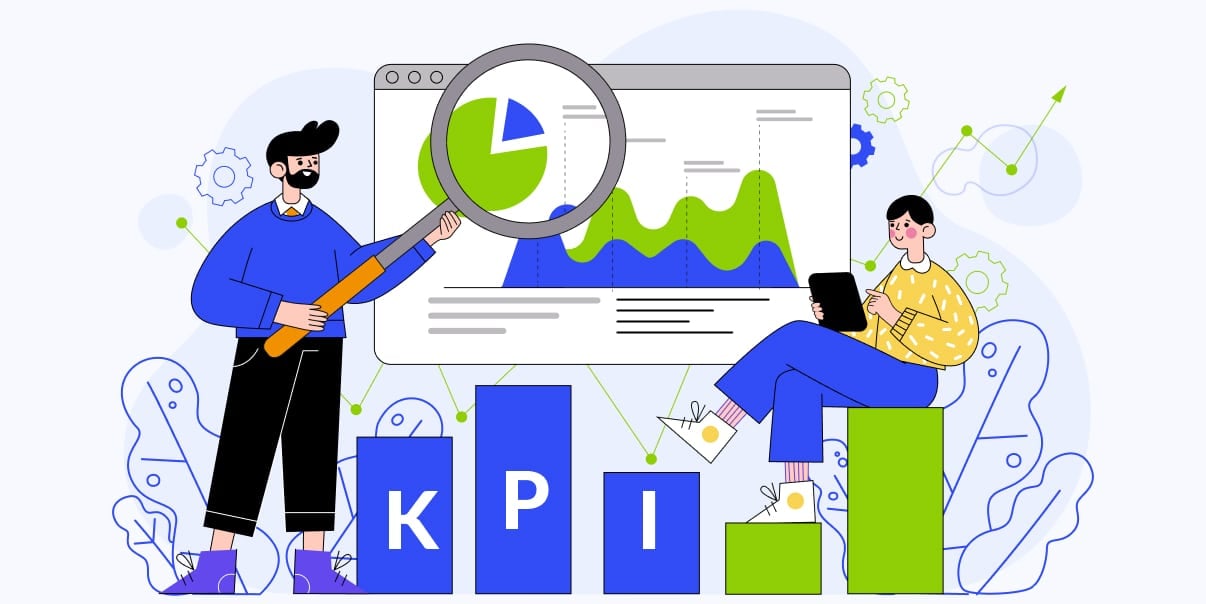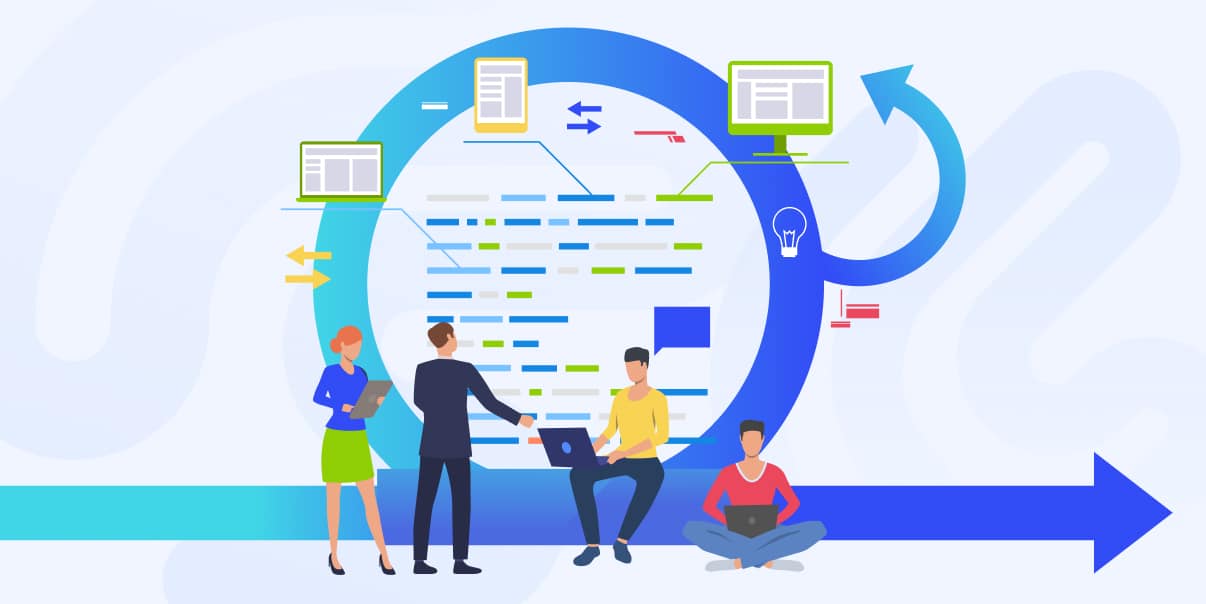Software Development KPI Metrics: Assessing Success and Progress

App development KPI metrics measure the success and progress of software development projects. KPIs, or key performance indicators, identify areas that need improvement. They help ensure that your project meets its goals.
Moreover, KPIs play an essential role in making business decisions. They help you know where to focus resources and how to allocate them. By having clear targets, software developers prioritize tasks more efficiently. It enables teams to deliver the right product at the right time.
This article will explain the purpose of using KPIs in software development. We will also discuss why aligning KPIs with company objectives is essential.
Identifying Business Objectives in Software Development
When developing software, businesses have goals they want to achieve. Some common objectives are increasing productivity, reducing costs, and improving user satisfaction. By establishing these objectives, companies can assess the development process’s flow. It will also help in setting up your KPIs.
Here are some questions to answer when identifying your company objectives in software development:
- What are the main goals of this software project?
- What metrics do you need to measure progress?
- How can you ensure that these KPIs align with your business objectives?
- Are there any changes required to meet those objectives?
By considering these questions, you can craft meaningful KPIs. Businesses can use KPIs to measure success and ensure they are developing the right product for their users.
You should also consider following these steps:
Distinguish What Is Important
Are there specific dates that are more important in the software development process? If so, you must use project management software to set those dates as project milestones. That way, what you must do and when you must finish them is clear.
These project milestones also keep team members focused on the bigger picture. They can encourage everyone to work together. The milestones can also motivate productivity and help the project stay on schedule.
Set Milestone Goals
Working on a software development project can seem overwhelming. But breaking down the tasks and setting goals can help make them more manageable. By selecting individual milestones for each process step, you can give each task more importance. It also helps motivate team members to work faster.
For example, some essential project milestones might include:
- Completing the software design process
- Finalizing software production
- Finishing all software testing
Once you set your milestones, team members can see how their work contributes to your goal. And with regular progress updates, you can encourage them to keep going.
Keep Things Practical
Developing a project is like running a marathon. You need clear, practical, and concise objectives to help you reach your goals. Objectives should be detailed enough so that you know what the result should look like.
Here’s what you need to remember when setting practical objectives:
- It is essential to meet all company goals and values
- Make sure to create a schedule and do your best to stick with it.
- Document every foreseeable development in your project.
Practice Clarity
When making objectives, it’s essential to be precise. Everyone involved in the project should understand what you are trying to achieve. Think about your goal and how you want the project to turn out when it’s done. Be specific and transparent with your objectives. This way, everyone knows the exact things they need to do.
Focus on the End Result
The result should be the primary focus when making objectives. After all, that is what you are trying to achieve with your project. Make sure everyone on the team knows the ultimate goal and works towards it. It will help keep motivation high and ensure that everyone is giving their best effort to reach success.
Your Objectives Must Be Testable
You can’t measure success without a way to test it. That’s why your objectives must be verifiable and quantifiable. It will give you tangible evidence of progress. This way, you can track the project’s performance and get an accurate view of where it stands.
Defining Key Performance Indicators (KPIs)
Once you have identified your business objectives, it is time to define KPIs. These are metrics that measure the progress and success of software development projects. You must choose the right metrics for your project and ensure they align with your goals.
Here are the four types of key performance indicators for software development:
1. Product Metrics
Software developers use metrics to measure their app’s success. They look at user satisfaction, feature use, and defects. Analyzing these helps developers make changes that meet customer needs.
Here are some of the product metrics in software development:
- Customer Satisfaction
- Feature Use
- Number of Bugs Reported
- User Engagement
- Time Spent On The App
- User Retention Rate
2. Process Metrics
Process metrics measure how efficient software development teams are. They help teams understand what processes need improvement. These metrics also let the team know which areas they need to optimize.
Here are some of the process metrics in software development:
- Development Cycle Time
- Defects Per Line Of Code (DPLC)
- Bugs Fixed Per Day
- Cycle Time
- Code Coverage (Unit Testing)
- Test Automation Rate
3. Project Metrics
Project metrics measure how successful software development projects are. They help teams understand which areas need improvement. It also helps ensure that the project meets its goals on time.
Here are some of the metrics for your software development projects:
- Project Completion Rate
- Time To Market
- Customer Interactions
- Budget Overruns
- Sprint Velocity (Scrum)
Collecting Data for Software Development
Once you have identified and defined your KPIs, it is time to start collecting data. You can do this through analytics software, project management tools, and surveys.
Analytics software provides detailed information about the performance of your software product. It helps you identify trends and insights that can help improve the software development process.
Meanwhile, project management tools help you track the progress of your team. You can ensure they complete all tasks on time and within budget.
Moreover, collecting data from your customers to understand their feelings about your software is essential. You can get this information through a customer feedback survey. You can use this data to make improvements and ensure customer satisfaction.
Tools For Data Collection
There are several tools available that help businesses collect and analyze data. Here are the most popular data collection tools in the market:
- Google Analytics. It allows companies to track website performance and user behavior on their websites.
- Splunk. It is a data analytics platform that helps companies to collect, store and analyze data.
- Jira. It is an issue-tracking tool that enables teams to track project progress and manage tasks efficiently.
- Mixpanel. This tool provides businesses with insights into user behavior on their software.
Businesses can use these tools to collect data and measure KPIs in software development projects. They can also ensure that their software meets its objectives and is thriving.
How To Identify Data Sources For KPI
The key to successful data collection is identifying suitable data sources. Businesses need to determine the data points they need to collect to measure their KPIs. Here are some tips for identifying data sources for KPIs:
- Research market trends and customer feedback
- Analyze competitors’ software products
- Monitor customer support tickets
- Review results from A/B testing
- Track usage data from software product
- Gather survey results from customers
Businesses can use these tips to identify suitable data sources for their KPIs. These will allow them to measure success and improve software development projects.
Analyzing Data With Software Development KPI
Data analysis is an essential step in software development. It helps businesses identify trends that help them understand their customers better. Companies can also use the data to identify areas for improvement.
Here are some tips on how to analyze data from software development KPIs:
Analyze Patterns
Examine the data you have, and try to find any patterns or trends. Doing this can help you understand how every decision can affect the outcomes. So you can avoid any issues and improve your software development process.
Compare Performance Software Development Metrics
Compare performance metrics, such as customer satisfaction scores and user engagement rates. It will help you better understand the impact of specific changes on the product’s success rate.
Identify Areas for Improvement
Look for areas where your developers can make improvements. See if you need to address any issues. You must also check if there are areas that need extra resources.
By identifying these areas, you can develop strategies to improve your app project’s performance.
Implementing Changes and Tracking Progress
Data analysis helps businesses identify areas for improvement. But it’s essential to implement these changes correctly. You also need to track the progress you make over time.
Here are the things you need to track in software development:
Team Velocity
Team velocity is the amount of work a team completes during a sprint. It helps you measure your software development team’s progress and productivity levels.
Story points are the most popular way to measure velocity. It’s like evaluating the size and time required to make a software product. After three sprints, you should know your team’s average speed. That will help see if their goals are realistic or not.
Sprint Burndown
Sprint burndown is a chart that shows the amount of work remaining for each sprint. It helps you track how well your team is performing and if there are any problems with their progress.
Release Burndown
Release burndown tracks the progress of a release, which is more significant than a sprint burndown. It lets teams know how they are doing with their product’s release.
A release burndown chart can tell if a team is on schedule, behind it, or ahead. The data from this chart can show businesses and stakeholders when they can get an ROI post-release. It also tells customers about delays or early releases.
Cumulative Flow
This chart shows the progress of tasks and how they move from one phase to another. It helps software development teams identify any bottlenecks in their process. This way, they can take corrective measures early.
The cumulative flow can also help teams look into task completion rates, cycle times, and throughput. It allows developers to understand the process and optimize it for better performance.
Flow Efficiency
This metric measures how you efficiently move work through the software development pipeline. It helps teams identify any inefficiencies in their process and improve them accordingly.
By tracking flow efficiency, developers can focus on areas that need improvement. They can also reduce costs and delivery times by ensuring that all tasks move through the pipeline efficiently.
Code Quality
This metric measures how good your code is. It helps software development teams identify and correct any issues with their code.
Developers should use static analysis and code review tools to measure code quality. You can also use automated testing tools if you prefer an easier way to do this. This way, you can ensure that their software is high quality and meets customer needs.
Code Churn
Code churn metric measures the number of changes made to a code base over time. It helps teams understand how often they need to make changes. It also lets you know if any issues arise due to frequent modifications.
By tracking code churn, teams can identify areas of the code base that are prone to changes. It ensures that their software is always up-to-date and running smoothly.
Reviewing and Adjusting KPIs
After collecting data for your KPIs, you must continuously review and adjust them as needed. It will help you ensure that your KPIs align with your business objectives.
Consider new data and feedback, such as customer reviews and market trends. Also, review the performance of your KPIs to identify any areas for improvement. It will help you make the necessary changes and ensure your software meets your goals.
Communicating Results of KPI Metrics
It’s vital to regularly communicate your software development KPIs’ results to stakeholders. It offers transparency between your team and stakeholders. By doing this, you can also correctly address any issues in your ongoing project.
Here are some tips for communicating KPI results better:
Create Regular Reports
The best way to communicate the KPI results is through regular reports. These reports should include relevant data, charts, and insights on the performance of your software product. Also, these reports can help stakeholders understand the progress and make decisions based on the data.
Make sure to keep these reports visual. It will help stakeholders quickly identify any areas of improvement.
Use Presentations and Webinars
You can also use presentations and webinars to communicate KPI results effectively. They are a great way to provide an overview of the progress and success of software development projects.
You must include relevant data, insights, and visuals in your presentations. It will help stakeholders understand how the project is progressing.
Communicate Through Email or Video Calls
You can also communicate KPI results through emails or video calls. It allows software development teams to provide a detailed overview of the progress. It also opens opportunities to share insights with stakeholders.
To make sure the message is clear, use visuals such as charts and graphs. It will help stakeholders quickly understand the data and take action accordingly.
By following these tips, businesses can ensure software development success. They can also communicate more effectively with stakeholders about their key performance indicators.
Using Data To Make Informed Decisions
Using data from KPIs helps your development team make informed decisions about their products. It also allows them to identify areas for improvement and ensure customer satisfaction.
Here are some tips on using software development KPI metrics to make better decisions:
Prioritize Features
Analyze the data from your KPIs to prioritize features that need development. It will ensure that your developers spend time and resources on essential elements.
Moreover, having priority features can help improve customer satisfaction. It keeps you from being off-track in the development process.
Allocate Resources
Data from KPIs can also help businesses allocate resources more efficiently. Companies can use the KPI results to identify areas where they need more resources. Then, they can adjust their budget accordingly.
Identify Areas for Training
KPIs also help businesses identify areas where their development team needs additional training. They allow them to focus on these parts and offer help to team members. They also ensure that your team is well-equipped with the necessary skills.
What Are Continuous Improvement KPIs?
It’s essential to continuously review and adjust KPIs to ensure alignment with company objectives. Use data from KPIs to identify areas for improvement and where to allocate resources. Then, you can also decide if your team needs training for improvement.
To do this, companies can use continuous improvement metrics. They will help you track how well you’re doing over time. They’re a great way to measure if the changes they make are helping and how much progress they are making.
Your software development team can improve by keeping an eye on this data.
For example, you can measure each KPI your team uses monthly. It will help you track the improvement in the team’s performance over time and make course corrections.
Here are some continuous improvement metrics that you can use:
- Safety
It’s essential to measure the safety performance of a software development project. It helps teams identify any issues with the process that may be causing delays or other problems.
- Productivity
You can measure productivity by tracking the number of tasks completed and their cost. It will help you accurately picture your team’s efficiency in completing projects on time.
- Cost
The metric cost measures the total cost your team spent on software development. It helps teams identify areas where they can reduce costs and improve efficiency.
- Quality
Aside from the cost, you also need to measure the quality of a software product. It helps teams identify any problems with their code. Then, you can make modifications to ensure their software is high quality.
- Return on Investment (ROI)
Meanwhile, the ROI metric measures the return on investment of a software development project. It helps teams understand how their software is performing. You will also know whether or not the app is providing value to the business.
- Time to Market
The time-to-market metric tracks how long it takes for a team to complete software development. It helps teams identify bottlenecks or areas where they could speed up their process. With this insight, you can optimize your workflow and delivery times.
- Employee Satisfaction
This metric measures employee satisfaction with their jobs. It helps modern software development teams identify any areas where they can improve. Also, it ensures that the team is motivated and productive.
- Net Promoter Score
Developers can use Net Promoter Score (NPS) to track their progress. It measures how user satisfaction with your products. You can also know how likely your customers will recommend your software.
By looking at the NPS data, teams can decide what changes to make to provide a better customer experience. The NPS helps keep track of the impacts of any improvement made over time.
Final Thoughts
To summarize, measuring key performance indicators (KPIs) in software development projects is vital. It helps companies understand their customers better and identify areas for improvement. By analyzing data from KPIs, businesses can also measure the success of their software products. They can also make sure that they meet customer needs.
Additionally, businesses should continuously review and adjust their KPIs for software development. It will help them ensure that they remain aligned with their business objectives. Are you planning to start a software development project but need help figuring out where to start? BIT Studios can help. Our experienced developers can help you identify the right KPIs for your project. Contact us today to get started.
We’re BIT Studios!
At BIT Studios we specialize in designing, building, shipping, and scaling beautiful, usable products with blazing-fast efficiency



